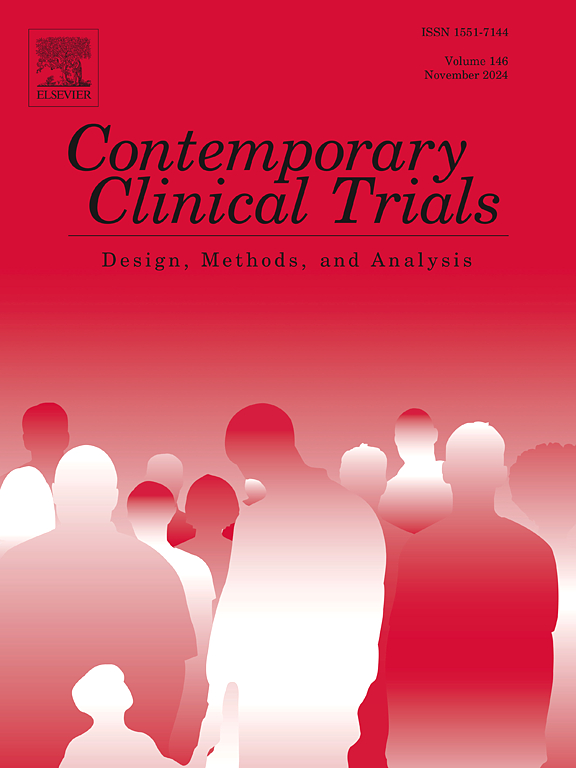Theory-based physical activity behavior change intervention in people newly diagnosed with multiple sclerosis: Study protocol for a pilot randomized controlled trial
IF 1.9
3区 医学
Q3 MEDICINE, RESEARCH & EXPERIMENTAL
引用次数: 0
Abstract
Background
Physical activity (PA) is strongly recommended for people newly diagnosed with multiple sclerosis (MS). Nevertheless, this MS sub-population is physically inactive, and this disease stage might require unique interventions for promoting PA.
Purpose
This proposed pilot randomized controlled trial (RCT) examines the effects of a remote-delivered, theory-based behavior change intervention for promoting PA in people newly diagnosed with MS.
Methods/design
The intervention was developed using a comprehensive approach guided by the Capability-Opportunity-Motivation-Behavior (COM![]() B) Model and the Behavior Change Wheel (BCW). This two-armed RCT (NCT06355804) will enroll 50 people diagnosed with MS within the past two years. Participants will then be randomly assigned, using computer-generated random numbers with allocation concealment, into either the PA intervention or waitlist control (WLC) conditions. Participants randomized into the PA intervention condition will receive the intervention following the baseline assessment, whereas participants in WLC condition will receive the intervention after the follow-up assessment (i.e., after 16 weeks). The primary outcomes of interest include device-measured (light PA [LPA], moderate-to-vigorous PA [MVPA], step counts) and self-reported (i.e., Godin Leisure-Time Exercise Questionnaire and International Physical Activity Questionnaire) PA. Secondary outcomes include fatigue, depression, anxiety, and health-related quality of life (HRQOL). Data will be analyzed with an intent-to-treat approach, using 2 (condition) by 2 (time) mixed-effects ANOVA with effect size estimates of eta-squared (η2) and Cohen's d.
B) Model and the Behavior Change Wheel (BCW). This two-armed RCT (NCT06355804) will enroll 50 people diagnosed with MS within the past two years. Participants will then be randomly assigned, using computer-generated random numbers with allocation concealment, into either the PA intervention or waitlist control (WLC) conditions. Participants randomized into the PA intervention condition will receive the intervention following the baseline assessment, whereas participants in WLC condition will receive the intervention after the follow-up assessment (i.e., after 16 weeks). The primary outcomes of interest include device-measured (light PA [LPA], moderate-to-vigorous PA [MVPA], step counts) and self-reported (i.e., Godin Leisure-Time Exercise Questionnaire and International Physical Activity Questionnaire) PA. Secondary outcomes include fatigue, depression, anxiety, and health-related quality of life (HRQOL). Data will be analyzed with an intent-to-treat approach, using 2 (condition) by 2 (time) mixed-effects ANOVA with effect size estimates of eta-squared (η2) and Cohen's d.
Discussion
The findings will inform a full-powered RCT of the intervention for promoting immediate and sustained changes in lifestyle, PA, health outcomes, and HRQOL in people newly diagnosed with MS.
基于理论的身体活动行为改变干预新诊断为多发性硬化症的人:一项试点随机对照试验的研究方案。
背景:强烈建议新诊断为多发性硬化症(MS)的患者进行身体活动(PA)。然而,这个MS亚群缺乏运动,这个疾病阶段可能需要独特的干预措施来促进PA。目的:本试点随机对照试验(RCT)探讨远程交付、基于理论的行为改变干预对新诊断为ms的人促进PA的效果。方法/设计:采用能力-机会-动机-行为(COMB)模型和行为改变轮(BCW)指导的综合方法开发干预。这项双臂随机对照试验(NCT06355804)将招募50名在过去两年内被诊断为多发性硬化症的患者。然后,参与者将被随机分配,使用计算机生成的带有分配隐藏的随机数,进入PA干预或等候名单控制(WLC)条件。随机分配到PA干预组的参与者将在基线评估后接受干预,而WLC组的参与者将在随访评估后(即16 周后)接受干预。主要研究结果包括设备测量的(轻度PA [LPA]、中高强度PA [MVPA]、步数)和自我报告的(即Godin休闲时间运动问卷和国际体育活动问卷)PA。次要结局包括疲劳、抑郁、焦虑和健康相关生活质量(HRQOL)。数据将采用意向治疗方法进行分析,使用2(条件)× 2(时间)混合效应方差分析,效应大小估计为theta -squared (η2)和Cohen’s d。讨论:研究结果将为一项全功能随机对照试验提供信息,以促进新诊断为MS的患者的生活方式、PA、健康结局和HRQOL的立即和持续改变。
本文章由计算机程序翻译,如有差异,请以英文原文为准。
求助全文
约1分钟内获得全文
求助全文
来源期刊
CiteScore
3.70
自引率
4.50%
发文量
281
审稿时长
44 days
期刊介绍:
Contemporary Clinical Trials is an international peer reviewed journal that publishes manuscripts pertaining to all aspects of clinical trials, including, but not limited to, design, conduct, analysis, regulation and ethics. Manuscripts submitted should appeal to a readership drawn from disciplines including medicine, biostatistics, epidemiology, computer science, management science, behavioural science, pharmaceutical science, and bioethics. Full-length papers and short communications not exceeding 1,500 words, as well as systemic reviews of clinical trials and methodologies will be published. Perspectives/commentaries on current issues and the impact of clinical trials on the practice of medicine and health policy are also welcome.

 求助内容:
求助内容: 应助结果提醒方式:
应助结果提醒方式:


